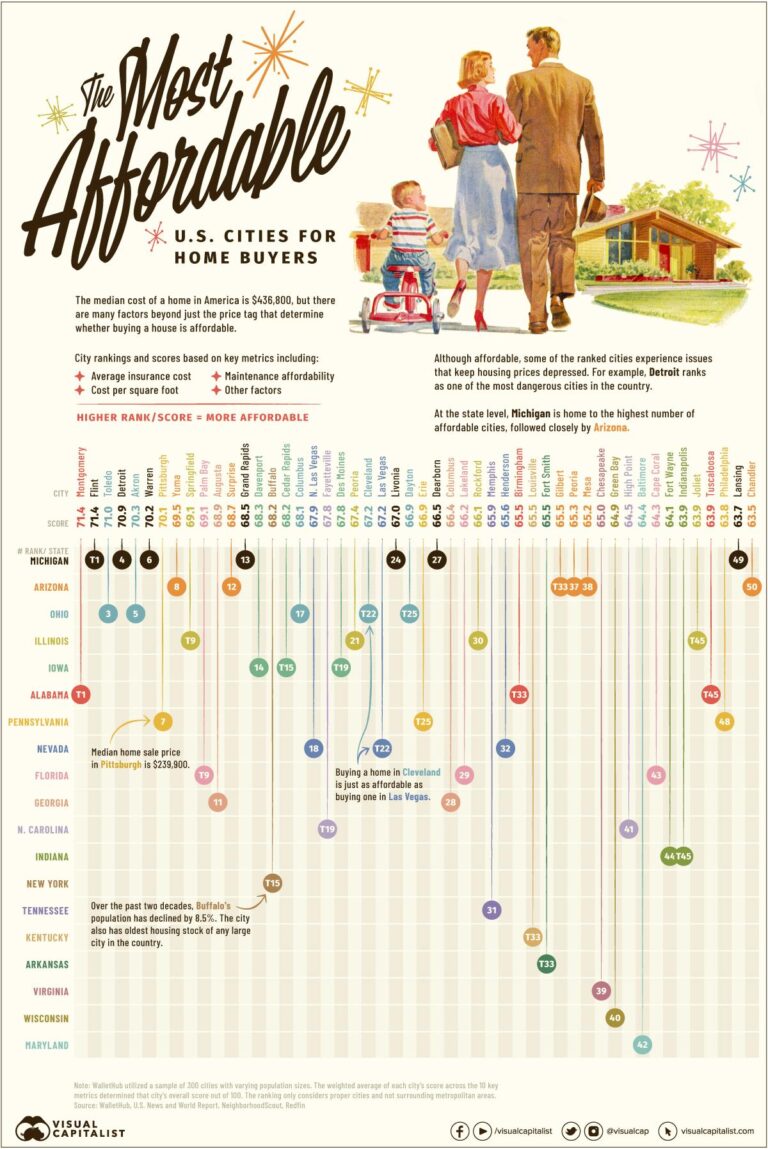Urban Housing Affordability: Emerging Opportunities in Key U.S. Cities
U.S. Cities Experiencing Notable Drops in Housing Costs
Across the United States, several prominent metropolitan regions are witnessing a remarkable transformation in their housing markets, characterized by significant price reductions. Cities like Chicago, Houston, and Phoenix have recently seen home values decline by double-digit percentages. This shift is largely fueled by a surge in housing availability combined with evolving buyer preferences. After years of steep price increases, these changes are making homeownership and renting more attainable for newcomers and relocating families.
These price adjustments are influencing more than just sale figures. The combination of lower listing prices and diminished buyer competition is resulting in:
- Decreased monthly mortgage obligations for new homeowners
- Enhanced bargaining leverage for purchasers
- Greater chances for renters to transition into owning their homes
This cooling trend in previously overheated markets may contribute to economic stabilization and foster sustainable growth within local housing sectors.
Key Drivers Behind Growing Affordability in Urban Real Estate
Multiple factors are converging to reduce housing costs in major U.S. cities. One significant influence is the changing migration patterns, where many residents are moving away from dense urban centers to suburban or smaller city environments with lower living expenses. This demographic shift alleviates demand pressures in expensive urban cores, encouraging more competitive pricing.
Additionally, increased construction activity supported by municipal incentives is expanding housing stock, helping to balance supply and demand. Economic conditions also play a role: wage growth has plateaued in many areas, while construction material prices have stabilized or decreased, easing upward cost pressures. Moreover, there is a growing preference for multi-family residences and mixed-use developments, which promote affordability through higher density living.
- Population redistribution reducing urban demand spikes
- Expansion of new housing projects in strategic urban locations
- Government programs encouraging affordable housing construction
- Economic adjustments moderating income and building expenses
- Shifts in lifestyle preferences favoring communal and flexible living spaces
| Factor | Effect on Affordability |
|---|---|
| Migration Trends | Mitigates rapid urban price increases |
| Housing Supply Expansion | Reduces competition among buyers and renters |
| Policy Incentives | Promotes development of affordable units |
| Economic Factors | Stabilizes construction and living expenses |
Neighborhood Features Enhancing Property Values
In many cities, neighborhoods that combine convenience with appealing surroundings are driving property appreciation. Locations near reputable schools, expanding transit networks, and a growing array of local businesses are attracting increased interest from both buyers and renters. Green spaces, recreational parks, and cultural venues further boost desirability, contributing to both lifestyle quality and sustained home value growth. For example, districts with pedestrian-friendly streets and vibrant café scenes often draw younger residents, fostering dynamic housing markets.
Modern amenities also play a pivotal role in shaping affordability and desirability. Facilities such as fitness centers, grocery stores, and community hubs have become essential factors influencing housing choices. Below is an overview of neighborhoods with key amenities linked to notable value increases:
| Neighborhood | Notable Amenities | Appreciation Rate (%) |
|---|---|---|
| Riverside Quarter | Light rail access, farmers market, bike lanes | 7.1 |
| Harborview | Waterfront trails, wellness centers, art studios | 6.5 |
| Cedar Grove | Highly rated schools, public library, boutique shops | 6.0 |
Essential Advice for Buyers in Emerging Affordable Markets
For those considering purchasing in these newly affordable urban areas, conducting comprehensive research on local economic trends and employment opportunities is vital to ensure long-term investment security. Don’t focus solely on low prices: affordability often indicates neighborhoods undergoing revitalization, with infrastructure upgrades and new developments on the horizon. Proximity to critical amenities such as schools, healthcare, and public transit should also factor into decision-making, as these elements influence both quality of life and future resale potential. Collaborating with knowledgeable local real estate professionals can reveal undervalued properties and upcoming community enhancements.
Financial readiness is equally important. Prospective buyers should secure mortgage pre-approval and explore loan programs tailored for first-time purchasers or those targeting less competitive markets. Consider these practical guidelines:
- Thoroughly assess property conditions: Rapid price shifts may mean some homes require costly repairs.
- Review neighborhood safety data: Lower prices might reflect changing crime rates worth investigating.
- Utilize real estate analytics: Monitor sales trends, market timeframes, and demand fluctuations through trusted platforms.
- Focus on long-term potential: Look for indicators like new schools or business openings signaling growth.
| Critical Factor | Significance |
|---|---|
| Employment Opportunities | Supports economic resilience and housing demand |
| Local Infrastructure | Enhances livability and property appreciation |
| Home Condition | Impacts initial investment and renovation costs |
| Community Growth | Indicates future neighborhood vitality |
Final Thoughts
While housing affordability remains a pressing issue for many Americans, these 11 metropolitan areas are emerging as promising markets where buyers and renters can find more attainable options. Although economic conditions and local policies differ widely, the trend toward improved affordability in these urban centers presents valuable opportunities for those seeking to enter or relocate within the housing market. Keeping a close eye on these developments is essential for stakeholders and prospective residents, as they may herald broader shifts in the national housing environment.




